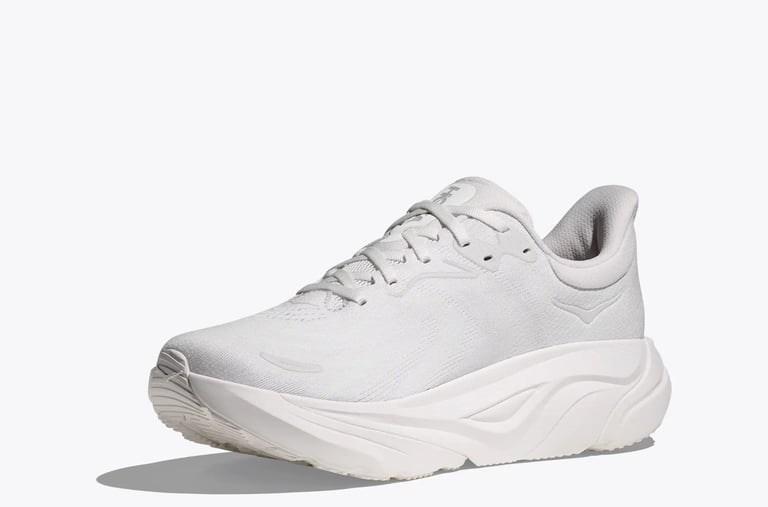Hoka Arahi 8 Review: A Softer, Lighter, Very Different Update to a Fan Favorite
GEAR & SHOE REVIEWS


The Hoka Arahi 7 was one of my all-time favorite do-everything shoes — the one I traveled with, ran in, walked in, and threw in the washer more times than I can count. So when the Hoka Arahi 8 arrived, I was eager to see whether this update preserved the magic… or rebuilt the shoe entirely.
The result? The Arahi 8 is lighter, softer, more plush, and noticeably different. Whether that’s good or bad depends on what you loved about the 7 — so here’s the full breakdown.
Model and Purpose
The Arahi series is designed as a run/walk hybrid. It’s intended for:
Nurses, workers, and anyone on their feet all day
Runners looking for one reliable, versatile shoe
Beginners who want support without stiffness
Hoka categorizes the Arahi line as stable with balanced cushioning, making it a structured yet comfortable option in their lineup.
Both the Arahi 7 and Arahi 8 share this intended purpose — but the experience isn’t identical.
Specs Compared: Arahi 8 vs. Arahi 7
Here are the key technical changes:
Weight
Arahi 8: 8.3 oz (women’s 8.5 measured)
Arahi 7: 8.6 oz (women’s 8.5 measured)
A noticeable drop in weight — the 8 is lighter.
Heel Drop
Arahi 8: 8 mm
Arahi 7: 5 mm
This 3 mm increase subtly changes the ride, especially when walking.
Stability & Cushion
Both models are listed as stable with balanced cushioning.
However, the Arahi 8 feels more plush than balanced.
Upper Material
Arahi 8: Stretchy double-layer jacquard mesh (62% nylon)
Arahi 7: Structured Flyknit, zero stretch
The upper is one of the biggest differences — the 8 feels softer and stretchier, the 7 more structured and clean.
Support Frame
Arahi 8: H-Frame
Arahi 7: J-Frame
The H-Frame provides a slightly different stability experience, making the 8 feel softer and more flexible overall.
Color Options & Price
The Arahi 8 comes in many colorways for both men and women, including:
Blush Rose
Latte Cream
Oyster Mushroom Truffle Salt
Midnight Blue Ultramarine
Classic Black and White
Price:
Women’s: $150
Men’s: varies $119–$150 depending on color availability
Key Features
Plush Heel Collar & Tongue
The heel collar remains plush and comfortable.
The tongue is now fully freestanding — no gusset, no elastic. Surprisingly, it stays in place well while running.
Stretchy New Upper
The 8’s upper is stretchy, softer, and more flexible than the Flyknit of the 7.
It is not necessarily more breathable, nor as dirt-resistant in the white colorway.
Softer Dual-Density EVA Midsole
The midsole is still EVA, but now with dual-density compressed EVA that feels noticeably softer than the 7.
H-Frame Stability
This stability system runs underfoot and provides gentle support.
It’s softer and more subtle than the J-Frame of the Arahi 7.
Durabrasion Rubber
The outsole rubber placement is almost identical to the 7 — excellent durability and excellent wear over time.
First Impressions
I’ll be honest — when I first unboxed the Arahi 8, I felt disappointed.
It looks more like a pure running shoe than a run-walk hybrid. The new upper fabric felt like it would get dirty quickly, especially in white. The stretchy upper also felt like a departure from the structured comfort I loved in the 7.
After learning the details — higher heel drop, new foam, new frame, stretchy mesh — I realized this wasn’t an “update.”
It’s a different shoe altogether.
But how does it run?
On-Foot Running Experience
After 20–30 miles, here’s what stood out:
Much more plush than expected
Still stable
Softer underfoot
Less responsive than the Arahi 7
Comfortable enough to run sockless
Great for easy runs and recovery days
Good for fatigue days or gentle jogging
While the Arahi 8 is marketed as “balanced,” it clearly leans plush. Not super bouncy, but soft and forgiving.
Walking Performance
This is where the 7 still wins for me.
The 8 mm heel drop is totally fine for running, but while walking it feels slightly less natural compared to the flatter, more grounded feel of the Arahi 7.
The stretchy upper also isn’t as dirt-resistant, which mattered to me because I wore the 7 everywhere.
Final Verdict
Is the Hoka Arahi 8 a bad shoe?
No — it’s a very good shoe.
Is it a replacement for the Arahi 7?
Also no — it’s a different experience entirely.
Choose the Arahi 8 if:
You want a soft, plush, supportive daily trainer
You prefer stretchy, comfortable uppers
You want one shoe for easy runs, errands, and daily wear
You’re a beginner or a walker needing gentle stability
Stick with (or stock up on) the Arahi 7 if:
You loved its structured feel
You want a lower heel drop
You want a cleaner, dirt-resistant upper
You want more response and versatility
This update might be the right direction for some runners — but for die-hard Arahi 7 fans, the difference will be noticeable.